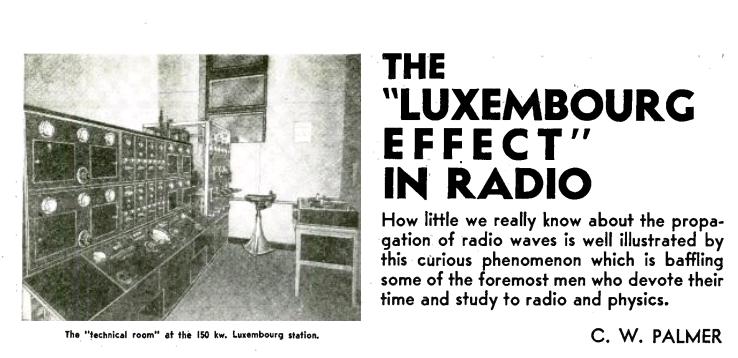An interesting ionospheric effect was first noticed about 80 years ago, and reported 80 years ago this month in Radio Craft magazine, February 1935. Radio Luxembourg operated on 252 kHz, with a powerful 150 kw signal designed to provide coverage in England.
The phenomenon was discovered in 1933 by B.D.H. Tellegen, in Eindhoven, Netherlands, who was listening to a station in Beromunster, Switzerland, on 652 kHz. In the background of the Swiss signal, he could hear the audio of Radio Luxembourg. This same phenomenon was reported by other listeners. Due to the distance between the three points involved, it could not be explained by the receiver being overloaded. The Luxembourg signal could be heard only when the Swiss station was transmitting.
Tellegen noted that the three points were in a straight line: When the signal from the Swiss station made its way to the Netherlands, it passed directly over Luxembourg. He correctly theorized that the carrier of the Swiss station’s signal was being modulated in the ionosphere as it passed through the strong signal of Radio Luxembourg in the ionosphere.
The ionosphere had only recently been discovered, and was not totally understood. It was previously supposed that the ionosphere was a linear medium, through which radio waves passively reflected. But the existence of the Luxembourg Effect showed that the ionosphere could be artificially “heated,” to produce non-linear effects.
Interestingly, the carrier frequency of the signal didn’t seem to be critical. The modulation of the interfering signal was superimposed on the other signal without regard to the carrier frequency. Subsequent research showed that most of the effect took place in the lower range of the audio frequencies.
Much to the dismay of conspiracy theorists, this is the phenomenon that the High Frequency Active Auroral Research Program (HAARP) was working with. It’s relatively easy to generate a strong radio signal in the High Frequency (HF) region. HAARP had transmitters that could generate 3.6 MW signals from 2.8-10 MHz and radiate them toward the ionosphere. This strong signal was able to generate the same kind of “heating” effects caused by Radio Luxembourg.
It’s more difficult to generate signals in the Extremely Low Frequency (ELF) region. Among other things, ELF signals are used to communicate with submarines. The main idea of HAARP was to generate these signals not in a transmitter, but in the ionosphere itself, by mixing two strong HF signals. For example, it would be practically impossible to generate a radio wave of 0.1 Hz with a transmitter. But by beaming two signals into the ionosphere, one at 4.000000 MHz, and one at 4.0000001 MHz, the result would be a radio wave, generated in the ionosphere, with a frequency of the difference, 0.0000001 MHz, or 0.1 Hz.
The phenomenon is sometimes called the Luxembourg-Gorky effect, since the powerful longwave transmitter at Gorky, USSR, produced similar effects.
References
- Probing the Northern Lights, Popular Mechanics, July 1999.
- PHD Dissertation by Juan Valentin Rodriguez, 1994, at page 5.
- Radio Science for the Radio Amateur by Eric Nichols
, page 11-7


Pingback: Scientists in Alaska Attempt to Produce Artificial Aurora | Scientist.ml
Pingback: Scientists in Alaska Attempt to Produce Artificial Aurora | Calypsas
Pingback: 1947 Chemtrails | OneTubeRadio.com
What were the conclusions from the HARP experiment?